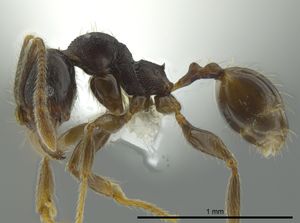Pheidole colobopsis
| Pheidole colobopsis | |
|---|---|

| |
| Scientific classification | |
| Kingdom: | Animalia |
| Phylum: | Arthropoda |
| Class: | Insecta |
| Order: | Hymenoptera |
| Family: | Formicidae |
| Subfamily: | Myrmicinae |
| Tribe: | Attini |
| Genus: | Pheidole |
| Species: | P. colobopsis |
| Binomial name | |
| Pheidole colobopsis Mann, 1916 | |
A Peruvian colony was collected in clay soil at the base of a tree in terra firme rainforest. The nest was 12 cm deep and contained a single queen, five majors, and about 200 minors. The majors and minors in this series are a nearly uniform dark yellow to amber color. (Wilson 2003)
| At a Glance | • Phragmotic |
Identification
See the description in the nomenclature section.
Keys including this Species
Distribution
Southern Mexico and south through Central America, plus roughly the northern half of South American (known from Venezuela, Columbia, Brazil and Peru).
Latitudinal Distribution Pattern
Latitudinal Range: 18.64° to -17.10527778°.
| North Temperate |
North Subtropical |
Tropical | South Subtropical |
South Temperate |
- Source: AntMaps
Distribution based on Regional Taxon Lists
Neotropical Region: Brazil (type locality), Colombia, Guatemala, Honduras, Mexico, Peru, Venezuela.
Distribution based on AntMaps
Distribution based on AntWeb specimens
Check data from AntWeb
Countries Occupied
| Number of countries occupied by this species based on AntWiki Regional Taxon Lists. In general, fewer countries occupied indicates a narrower range, while more countries indicates a more widespread species. |

|
Estimated Abundance
| Relative abundance based on number of AntMaps records per species (this species within the purple bar). Fewer records (to the left) indicates a less abundant/encountered species while more records (to the right) indicates more abundant/encountered species. |

|
Biology
Castes
Worker
Minor
Images from AntWeb
    
| |
| Worker. Specimen code casent0619698. Photographer Jeremy Pilllow, uploaded by University of Utah. | Owned by JTLC. |
Major
Images from AntWeb

| |
| Worker (major/soldier). Specimen code casent0619464. Photographer Jeremy Pilllow, uploaded by University of Utah. | Owned by JTLC. |
Queen
Images from AntWeb
    
| |
| Queen (alate/dealate). Specimen code casent0619476. Photographer Jeremy Pilllow, uploaded by University of Utah. | Owned by JTLC. |
Nomenclature
The following information is derived from Barry Bolton's Online Catalogue of the Ants of the World.
- colobopsis. Pheidole (Pheidole) colobopsis Mann, 1916: 439, pl. 3, figs. 25, 26 (q.) BRAZIL. Combination in P. (Scrobopheidole): Emery, 1922e: 112. See also: Wilson, 2003: 545.
Unless otherwise noted the text for the remainder of this section is reported from the publication that includes the original description.
Description
From Wilson (2003): DIAGNOSIS A typical member of the lamia group: the major has a phragmotic head, with the anterior portion incorporating the clypeus and mandibles flattened (truncated), and deep antennal scrobes. This species is easily distinguished from the other members of the lamia group (Pheidole lamia, Pheidole pelor, Pheidole truncula) by the shorter head of the major and the pattern of carinulae on its head: limited to dense longitudinal rows on the frontal lobes and frontal triangle and transverse rows on the lateral wings of the clypeus. Other differences in body form and sculpturing are as illustrated. The queen is also phragmotic.
MEASUREMENTS (mm) Major (Rio Porce, Colombia): HW l.08, HL l.20, SL 0.54, EL 0.l4, PW 0.60. Minor (Rio Porce, Colombia): HW 0.52, HL 0.54, SL 0.52, EL 0.06, PW 0.32.
COLOR Major: mostly light reddish brown; appendages, the truncated front of the head, and a narrow horizontal strip posterior to the eyes dark yellow.
Minor: body and scapes medium reddish brown, other appendages yellowish brown.
Figure. Upper: major. Lower: minor. COLOMBIA: Rio Porce, near Medellin, 1020 m, col. Neal A. Weber. Scale bars = 1 mm.
Type Material
Rondonia Mamore railway track, Km 306, Rondonia, Brazil. National Museum of Natural History - as reported in Wilson (2003)
Etymology
Gr colobopsis, docked, clipped, shortened, with reference to the truncated head of the major. (Wilson 2003)
References
- Emery, C. 1922e. Quelques fourmis nouvelles minuscules. Ann. Hist.-Nat. Mus. Natl. Hung. 19: 107-112 (page 112, Combination in P. (Scrobopheidole))
- Mann, W. M. 1916. The Stanford Expedition to Brazil, 1911, John C. Branner, Director. The ants of Brazil. Bulletin of the Museum of Comparative Zoology 60: 399-490 (page 439, pl. 3, figs. 25, 26 queen described)
- Wilson, E. O. 2003. Pheidole in the New World: A dominant, hyperdiverse ant genus. Harvard University Press, Cambridge, MA.(page 545, fig. major, minor described)
References based on Global Ant Biodiversity Informatics
- Achury R., and A.V. Suarez. 2017. Richness and composition of ground-dwelling ants in tropical rainforest and surrounding landscapes in the Colombian Inter-Andean valley. Neotropical Entomology https://doi.org/10.1007/s13744-017-0565-4
- Ahuatzin D. A., E. J. Corro, A. Aguirre Jaimes, J. E. Valenzuela Gonzalez, R. Machado Feitosa, M. Cezar Ribeiro, J. Carlos Lopez Acosta, R. Coates, W. Dattilo. 2019. Forest cover drives leaf litter ant diversity in primary rainforest remnants within human-modified tropical landscapes. Biodiversity and Conservation 28(5): 1091-1107.
- Dattilo W. et al. 2019. MEXICO ANTS: incidence and abundance along the Nearctic-Neotropical interface. Ecology https://doi.org/10.1002/ecy.2944
- Fernández, F. and S. Sendoya. 2004. Lista de las hormigas neotropicales. Biota Colombiana Volume 5, Number 1.
- Longino J. T. 2013. Ants of Nicargua. Consulted on 18 Jan 2013. https://sites.google.com/site/longinollama/reports/ants-of-nicaragua
- Longino J. T. L., and M. G. Branstetter. 2018. The truncated bell: an enigmatic but pervasive elevational diversity pattern in Middle American ants. Ecography 41: 1-12.
- Longino J. T., and R. K. Colwell. 2011. Density compensation, species composition, and richness of ants on a neotropical elevational gradient. Ecosphere 2(3): 16pp.
- Longino J. et al. ADMAC project. Accessed on March 24th 2017 at https://sites.google.com/site/admacsite/


